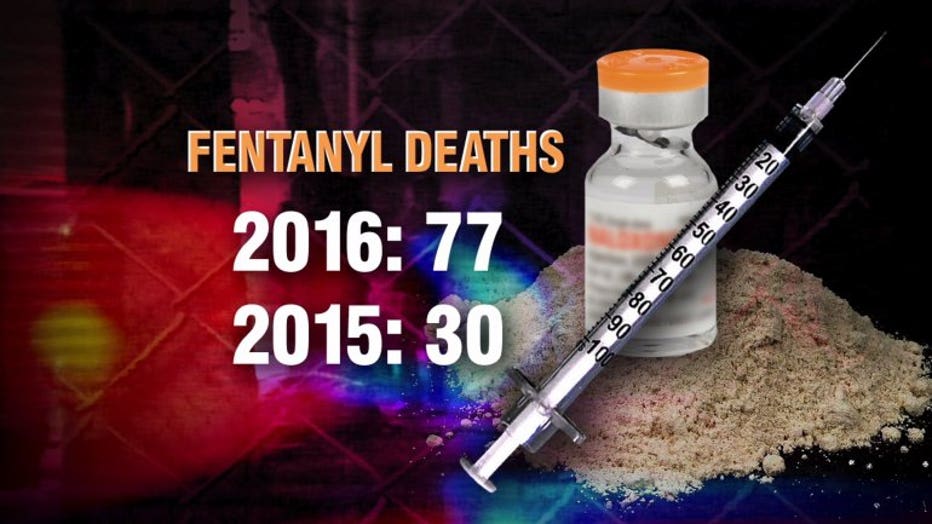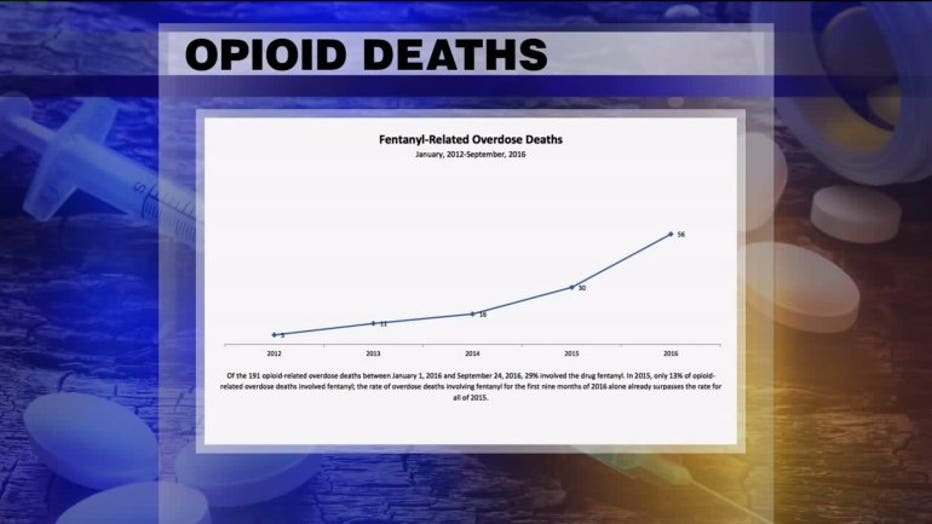"This has to stop:" 77 fentanyl-related deaths in 2016 -- 120 percent increase over last year
MILWAUKEE -- With three days left in 2016, officials with the Milwaukee County Medical Examiner's Office said Thursday, December 29th there have been 77 fentanyl-related deaths in Milwaukee County in 2016.
The medical examiner said this is a 120 percent increase from 2015.
"This has to stop. It's just awful, it's just awful to see this many people die from such a preventable death," said Karen Domagalski, Milwaukee County Medical Examiner's Office.
In the past 24 hours, the Milwaukee County Medical Examiner has seen three probably overdose deaths. It's become the norm in the office that will see record highs for overdoses this year.
"Almost every day, we are responding to a drug overdose," said Domagalski.
So far, 2016 has brought 290 overdose deaths up from 255 in 2015 -- with at least 50 cases still pending.

127 have been heroin related. And 77 have been fentanyl deaths -- up 120 percent from last year.

"It's a strain on our resources, it's a strain on our staff, it's a strain on our toxicology department, but we are handling it well," said Domagalski.
"It doesn't surprise me at all. It's happening three, four, five, sometimes six times a month," said President of Max A. Sass and Sons Funeral Home, Steven Sass.
The consequences of opioid addiction are seen regularly.
"I've never seen sorrow quite as deep and affecting and as destructive as I have with these heroin deaths," said Sass.
The funeral home previously put up billboards addressing the heroin epidemic. A small contribution to what they say is a huge problem.

"I fear that our numbers are going to rise," said Sass.
Back at the ME's Office, similar concern -- a plea for a community to change in the new year.

Karen Domagalski
"Stop doing this, get help if you need it. If you see someone who needs help, step in if you can," said Domagalski.
Adding to the strain, the ME's Office says drug-related deaths cost more. There are added tests that have to be done for each case. They say they are keeping up with the workload.
Fentanyl is a potent, synthetic opioid pain medication with a rapid onset and short duration of action. It is estimated to be between 50 and 100 times as potent as morphine.
It is a schedule II prescription drug, and it is typically used to treat patients with severe pain or to manage pain after surgery. It is also sometimes used to treat patients with chronic pain who are physically tolerant to other opioids.
In late November, Alderman Michael Murphy, citing a study conducted by the Medical College of Wisconsin, said Milwaukee County was on pace to "significantly eclipse" the 231 heroin and opiate overdose deaths in the county in 2015.
At that point in time, there had been 70 fentanyl-related overdose deaths in the county.
A report from the Milwaukee County Medical Examiner's Office shows through September 24th, 2016 -- 191 people had fallen victim to opioid overdoses -- compared to 176 by September 24th, 2015.
Alderman Murphy said if overdose deaths continued at this rate in Milwaukee County, the total figure for the year 2016 would exceed 250 (vs. 231 in 2015).
“It’s alarming because the issue is getting more attention than ever before, and yet still the rate of overdoses is climbing. What’s more, the breakdown of data by race, by age and by geographic location shows the problem is as ubiquitous as ever. Absolutely anyone in any part of the county can fall victim," Alderman Murphy said in the statement.

The report notes that through September 24th, 2016, the drug fentanyl was identified as a contributing factor in 56 overdose deaths—compared to 30 deaths in all of 2015, 16 in 2014, 11 in 2013 and five in 2012.
"If you've seen the trend over the last few years, whatever we are doing is not working. You would think with all of the attention that the media has spent on it, a lot neighborhood meetings, public meetings, you would think those numbers would start going the other way, but they haven't," Murphy said.

Alderman Michael Murphy
According to the statement from Alderman Murphy, if these deaths continued at the current rate, the number of fentanyl overdose victims in 2016 would eclipse those in the last four years combined.
“Fentanyl is a powerful and dangerous drug that we see more and more frequently in overdose cases. In some cases, users may know that fentanyl is present, but in many cases it may be mixed into their drugs without their knowledge. Fentanyl is always dangerous when used without medical supervision," Dr. Brooke Lerner, who is leading the Medical College of Wisconsin’s analysis of data from the Milwaukee County Medical Examiner’s Office said in the statement.

The analysis of data from the medical examiner is taking place as part of a two-year community-based, data-driven partnership between the City of Milwaukee, the Zilber Family Foundation and the MCW’s Department of Emergency Medicine to examine key metrics of the heroin and opiate abuse epidemic, Murphy said.
The Milwaukee COPE (Community Opioid Prevention Effort) got underway earlier this year under legislation sponsored by Alderman Murphy, and regular updates are expected as the initiative proceeds, Alderman Murphy's statement said.
To best utilize the data, Alderman Murphy introduced Common Council legislation creating a City-County Heroin and Opioid Task Force charged with studying the problem further and presenting policy recommendations to address the issue -- composed of representatives from the Common Council, Milwaukee Health Department, Police Department, Fire Department, Milwaukee County Circuit Court, Intergovernmental Relations, County Executive’s office, the community and the medical profession.

"The task force is going to bring together law enforcement, medical professionals, treatment providers and addicts themselves to give us a better perspective about how we can change this course," Murphy said. "As we continue to better understand the breadth of the heroin and opiate abuse epidemic, the next step is to translate facts into action. By bringing together experts from both the public and private sectors and multiple government jurisdictions, I hope to be able to craft an effective set of policy recommendations that can help reverse this startling, deadly trend."

Heroin
Alderman Murphy said this community effort is augmented by the launch of the Drug Mail Back Program championed by Alderman Jim Bohl.
The program creates a safe, convenient method to dispose of unused or unwanted medication, reducing the opportunities for surplus medication to contribute to addiction issues.


